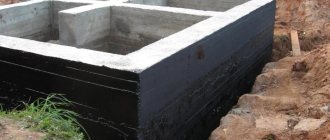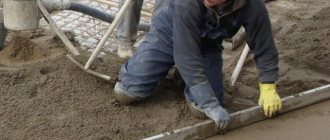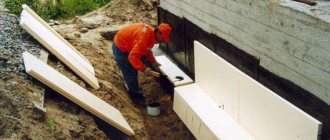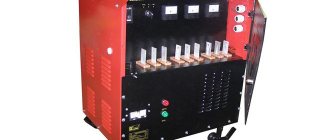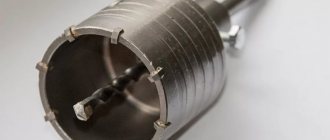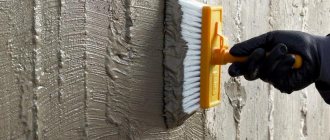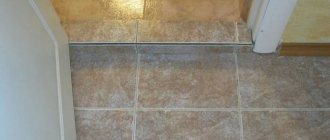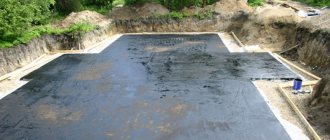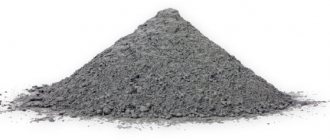Cement waterproofing provides protection for various structures from moisture. Materials of this group are often used due to many advantages. Proper mixing of components ensures high reliability and increases the service life of the coating. There are different types of cement-based mixtures. When choosing, their composition and properties are taken into account.
Cement based waterproofing
The high advantages of cement materials: efficiency, ease of use, strength, environmental friendliness, durability have ensured their widespread use.
Cement-based waterproofing is a vapor-permeable material with high adhesion to concrete (the maximum adhesion among all waterproofing materials), which makes it preferable when installing internal tear-off waterproofing.
Main types
Coating cement materials are divided into rigid (dry mix) and flexible (dry mix + polymer emulsion).
Hard materials (cement-sand mixtures) are mixed with water and applied in a paste form to a damp surface.
Flexible two-component polymer-cement materials are similar in composition to cement coating materials, but are sealed with an aqueous polymer emulsion, and therefore are much more expensive. They are supplied in the form of a dry mixture in a bag and an emulsion canister.
Polymer-cement coatings are elastic and do not tear when shrinkage cracks appear in the structure being coated with an opening of up to 0.5 mm, and when reinforced with alkali-resistant mesh - up to 1.5 mm.
| Indicators | Cement based waterproofing | ||||
| Hard coating | Flexible coating (polymer cement) | ||||
| Waterproofing thickness in 2 layers, mm | 3. 5 | 2. 3 | |||
| Consumption of dry mixture kg/m2 | 5. 8 | 3. 5 | |||
| First layer exposure time | 5. 24 | 3. 24 | |||
| Application temperature, C° | +5 –+30 | +5 –+30 | |||
Reinforcement of flexible waterproofing
The most vulnerable places in a structure when applying cement-based waterproofing are the sealing of joints, joints, seams, etc.
In places where cracks may form (junctions, transitions, joints, etc.), it is necessary to provide reinforcement of the polymer cement coating with strips of alkali-resistant mesh 20-30 cm wide.
The reinforcing mesh is embedded in the first layer of freshly laid material and, after curing, is covered with a second layer of waterproofing.
Waterproofing care
The use of cement-based waterproofing materials requires careful moisture maintenance of the treated surfaces in order to prevent premature drying of the hardened mortar and the formation of shrinkage cracks.
Caring for the waterproofing coating, including regular watering, covering with plastic film, wet materials (matting, tarpaulin), etc., is especially important during the first 2-3 days.
First of all, care is required for thick-layer cement waterproofing, which is prone to the formation of microcracks in the presence of high temperatures, drafts, etc.
Coating polymer-cement waterproofing is more resistant to cracking and often does not require special care after its application, but just in case it is usually covered with plastic film.
Waterproofing technology
Technology for waterproofing using cement-based materials:
- cleaning the insulated surface from dust, dirt and other substances that weaken the adhesion of the mortar mixture to the base;
- surface saturation with water;
- applying the first layer of mortar using a spatula, brush or roller on a damp (without free water) base;
- keeping the laid layer for a certain time, caring for it;
- applying the second and subsequent layers on the already hardened but not dried previous one (using the “wet on wet” method).
When installing coating polymer-cement waterproofing, the direction of movement of the tool when applying each subsequent layer should be perpendicular to the previous one.
Varieties by composition
When choosing, take into account the type of components and the structure of the mixture. The material is selected taking into account the intended purpose of the enclosed structure and operating conditions. Waterproofing must correspond to the temperature conditions at which it will be applied and serve in the future. Violation of this condition will lead to the gradual destruction of the protective layer.
Cement-sand waterproofing
The composition is produced in the form of a dry mixture. This is the simplest type of waterproofing in terms of properties, which is due to the use of cement as the main component. The mixture is quite hard; during the drying process, the protective coating should be moistened frequently - up to 3 times a day for 2 weeks.
For application, it is recommended to use the method of spraying the composition using special equipment. The main purpose of the cement-sand mixture is to protect the monolithic foundation of objects. If you plan to apply waterproofing yourself, you need to add special additives to increase the density of the composition. Without them, the service life of the waterproofing will be shortened, and the coating will not perform its functions.
The mixture is applied sequentially several times. When the work is completed, it is recommended to protect the enclosed structure from possible damage while it dries.
However, the surface of the waterproofing layer can still be deformed. In this case, moisture evaporates unevenly, which leads to a change in the volume of the cement mixture with different intensities.
With added latex
This composition ensures the plasticity of the material. Latex increases the resistance of waterproofing to cracking. The material withstands the effects of temperature changes and low values of this parameter much better. As a result, the cement mixture resembles liquid rubber in appearance and properties. After applying the material, an impermeable coating is obtained that reliably protects the enclosed structure from moisture.
You can add latex to the cement mixture yourself, observing the proportions. However, it is much easier to use a ready-made mixture.
Mandatory conditions when working with such material:
- using the shotcrete or spraying method on a surface that has previously been carefully prepared;
- the mixture should be hot.
The result is a seamless coating that does not allow moisture to pass through, does not crack, is resistant to mechanical stress and lasts a long time, and also withstands high temperatures.
With liquid glass
This component is added to the cement mixture, which improves the properties of the rigid cement-sand mortar. Most often, the material is used to protect foundations, basement floors, and to form fire-resistant coatings.
Advantages of compositions based on liquid glass:
- protection from high temperatures;
- high adhesion;
- manifestation of antiseptic properties;
- absence of toxic components in the composition.
Different ways to use:
- liquid glass is applied to seams, joints, cracks, this option is used as an auxiliary measure; after applying waterproofing of this type, roll material is also used;
- Liquid glass is used as the main component of a cement mixture intended for pouring a foundation.
Cement-polymer
The composition includes Portland cement, sand, plasticizers. Cement-polymer waterproofing has improved properties. The main advantage of this material is considered to be high resistance to tensile and tearing loads. This is due to the formation of molecular bonds when combining polymer components and cement. As a result, the enclosed structure can withstand dynamic loads well and is resistant to cracking.
There are different types of polymer cement mixtures:
- waterproofing glue;
- waterproofing.
There are one- and two-component formulations. Moreover, the second option is more common. It contains acrylic emulsion and microfiber. This material is used when there is a high risk of exposure to deformation loads (cracks of more than 1 mm are formed). In other cases, dry one-component mixtures can be used.
Content
Pure cement is used as additional waterproofing for cast iron sewer pipes. Special waterproofing concretes have been developed, which are used in the construction of hydraulic structures, subways, and swimming pools. However, for a long time it was not possible to create a cement composition based only on mineral fillers that would be easily applied to the surface and guaranteed not to allow moisture to pass through. Success was achieved in the last third of the twentieth century, when European and American chemist-technologists began experimenting with polymer materials. Modern cement waterproofing is a reliable and durable material that is not inferior, and in some respects superior, to bituminous materials. At the same time, it is inexpensive and easy to use.
General characteristics
The main advantage of dry mixes is their compatibility with almost all surfaces. They are extremely easy to use and do not require special equipment or skills. Typically, this is a dry powdery material. By diluting the mixture with water or special compounds, a plastic waterproofing mass is obtained.
The price of dry waterproofing is determined by its composition and purpose. A wide variety of combinations of fillers and additives makes it possible to choose the best option for any purpose, be it insulating a bathroom or a swimming pool.
Almost all dry waterproofing mixtures consist of three components:
- Binder (cement, resin).
- Fillers (mica, perlite, quartz, pigments).
- Chemical additives (plasticizers, polymers, hardening accelerators, water-repellents).
The manufacturing technology involves grinding the components to the required size. After this, the composition is dried, mixed in the required proportions and packaged in bags of various sizes.
Cement-based waterproofing and its application
This type of coating waterproofing and the method of applying it to the surface of walls is somewhat reminiscent of working with plaster. If you pay attention to practice, this process can be divided into the following sequential actions:
- at the first stage, all dirt and dust, as well as remaining traces from the previous coating, are removed from the surface where waterproofing will be carried out;
- further, after the surface is prepared, it must be thoroughly saturated with moisture;
- While the wall surface is drying, you can start preparing cement-based waterproofing. To do this, you will need to combine the liquid emulsion with the dry mixture;
- After the solution is ready, it must be evenly applied to the wall surface using a spatula. Further leveling of the waterproofing layer is carried out using the rule.
Review of popular brands
Experts recommend purchasing dry mixtures only from well-known brands and carefully studying the attached documentation, since there are too many counterfeit products on the market. Among the reputable manufacturers that have won the trust of customers are the following brands:
Knauf
The most famous German manufacturer of various building mixtures. The range includes both cement-based and gypsum-based compositions.
To organize the screed, you can choose the Ubo cement mixture, which has improved thermal insulation properties. This was achieved through the use of polystyrene foam granules. When using this filler, the resulting products are characterized by strength and increased heat and sound insulation properties.
Another floor line from the same brand is “Boden”. It includes products with various numerical designations. For example, “Boden 15” is a composition for forming an ultra-thin layer with a thickness of 2-15 mm. “Boden 25” is poured in a thicker layer and allows leveling differences in surface height up to 30 mm. When it is necessary to prepare a floor with large differences in height, the manufacturer suggests using the Boden 30 mixture. With its help it is possible to apply a layer of up to 80 mm.
Ceresit
Several floor mixtures are produced under this brand. For example, “Ceresit CN 80”, which can be poured up to 80 mm thick. And you can walk on the flooded surface after 8 hours.
The product “Ceresit CN 808” is considered ultra-strong and also has increased wear resistance. This allows you to use it inside and outside buildings, and also operate it even without a topcoat.
The “CN 175” screed, presented as a self-leveling mixture, is distinguished by its universal action. Filling thickness – up to 60 mm.
"Osnovit"
One of the leading domestic manufacturers of building mixtures. To fill the floor, you should purchase the compositions “Startoline 41” and “Mixline T-44”. The first is recommended for combination with warm floors. The second can be applied in a thick (up to 150 mm) layer. This can be done manually or using special equipment.
"Volma"
Russian manufacturer, whose history begins in the 1940s. Over the past period of its existence, the company has developed many unique formulas, special criteria for evaluating and controlling product quality. Floor mixtures include 5 items. For rough screed inside and outside the premises, Volma Rovnitel rough is produced from cement, lime and sand, with the addition of synthetic components and fiber fibers. It is characterized by increased strength, wear resistance, and is suitable for underfloor heating.
"Volma Nalivnoy Arena" is also suitable for thick screeds, but has greater fluidity. The scope of application of the Volma Level Express composition is exclusively internal heated objects with normal humidity levels. This is a gypsum-based mixture that is suitable for both rough and finishing pouring, and is also compatible with the “warm floor” system - it functions as a heat-accumulating screed.
"Volma Leveling Top" is used in cases where an ultra-thin screed is required and increased operating loads are expected, including high humidity. The thickness of the coating can be 3-20 mm.
Volma Level Comfort also allows you to achieve the thinnest possible screed. For indoor use only.
The principle of operation of penetrating cement waterproofing and its advantages
Waterproofing with cement-sand mortar has been used for a long time. This is the so-called plaster waterproofing. It is applied to the foundation walls both outside and inside. The cement mortar effectively blocks the access of moisture to the concrete blocks; in addition, tiles or paint can be easily applied to the plastered interior walls of the basement.
Despite a number of advantages, cement waterproofing also has disadvantages:
- The application process is very labor-intensive and requires the performer to have skills in plastering walls using beacons
- An ordinary solution of sand and cement does not have elasticity, is quite fragile and cracks in the event of foundation subsidence.
- A crack is a damaged waterproofing
- Over time, the layer of cement mortar is still saturated with moisture and some of it penetrates into the concrete walls of the foundation
Modern penetrating waterproofing compounds or penetrating polymer-cement waterproofing do not have such disadvantages. Despite the fact that the principle of using dry sand-cement mixtures to protect concrete surfaces was invented about 50 years ago, we began to use it only recently. The idea is based on the application of an aqueous mixture of fine cement, quartz sand, active chemical additives and a crystallizing polymer.
When it hits the surface of concrete, the solution penetrates deeply into the cement stone of the concrete structure and fills its pores and cracks. The polymer and cement added to the composition for waterproofing leads to the formation of thread-like crystals. The crystals significantly compact the concrete structure, making it 20% stronger and almost completely waterproof throughout the entire period of operation.
Protected by penetrating polymer-cement waterproofing, the foundation is able to withstand the enormous pressure of groundwater. Thus, in laboratory tests, a concrete sample 5 cm thick, treated with a cement waterproofing mortar, remained dry when exposed to a column of water 123 m high for several days.
The advantages of penetrating waterproofing mixtures include the following: cement-based waterproofing can be applied to wet concrete, unlike bitumen roll or mastic waterproofing. Easy to use - the liquid solution is applied with a spatula, brush or broom to the concrete surface.
After polymerization, the concrete is compacted and becomes completely waterproof. Despite the fact that the treated surface does not allow water to pass through, concrete retains the ability to “breathe” thanks to micropores in the whiskers. This makes the surface vapor permeable.
Application
Cement-based waterproofing is excellent for treating communications passing through foundation walls (water and sewer pipes). Due to the presence of polymer in the mixture, the waterproofing layer has elasticity, which prevents the appearance of cracks.
Our experts will tell you more about foundation waterproofing in the following video:
Peculiarities
Waterproofing mixtures are used to protect various surfaces from water: floors, walls and ceilings, seams and cracks in concrete, etc. Cement-based materials have become widespread. This is due to its reasonable price and relatively simple use.
Although cement absorbs some moisture, mixtures containing this component provide high protection against water. At the same time, there are no contradictions in properties, since in the manufacture of cement-based waterproofing, special additives are used that repeatedly improve the characteristics of the material.
For waterproofing surfaces, compositions containing prestressing cement are used. It is distinguished by increased strength and resistance to cracking. Compared to other brands, this cement absorbs moisture minimally. The use of hydrophobic additives and plasticizers helps to increase resistance to water and enhance reliability by increasing the plasticity of the mixture.
Waterproofing is applied in a layer of significant thickness, due to which the structure being treated is better protected. The principle of application is similar to the method of using plaster mixtures. Thanks to the waterproofing layer, condensation does not form, which gradually destroys the structure and cladding. As a result, the fenced surfaces retain their attractiveness longer and also last a long time.
Cement based waterproofing. Step-by-step instruction
Before starting work, you should carefully study the manufacturer's recommendations. Basic instructions for applying cement waterproofing materials:
- Cleaning the surface from dirt, dust, and grease stains.
- Treating the surface with primer solutions using a roller and brush (in the joint area).
- Sealing seams and joints with protective sealing tapes. If necessary, fill seams and cracks with a repair mixture or seal.
- Carefully apply the waterproofing solution using a spatula and brush. Exposure, application of the second and subsequent layers.
Types of cement waterproofing
According to their purpose, cement waterproofing is divided into several types:
- Coating waterproofing;
- Suture;
- Plastering;
- Penetrating waterproofing;
- Repair mixture;
- Waterstops;
- Additives to concrete.
Coating waterproofing
Compositions based on modified cement or bituminous materials. Existing varieties of such waterproofing products make it possible to choose a solution for the treatment and protection of structures subject to deformation, contact with drinking water, and those located in aggressive environments.
Elastic suture insulation
Used for sealing joints of prefabricated reinforced concrete structures of basement walls and tanks, as well as in areas where there is a high probability of cracks.
Plastering
Used for waterproofing surfaces that are not subject to any deformation. These are mainly foundations, basement and basement walls, floors, pools and liquid storage tanks. Can be used both externally and internally.
Penetrating cement mixtures
They contain a large number of polymers that can penetrate deeply into the surface being treated, crystallizing in microcracks and pores. A special property of penetrating insulation is that, under the influence of moisture, it is able to penetrate deeper into the treated material, while simultaneously strengthening its strength over many years.
Repair compounds
Special compositions based on cement and modifying additives. They can be used both for local restoration and for repairing the entire surface of a structure. In addition to eliminating mechanical damage, they can increase the strength and waterproofing properties of the structure.
Waterstops
Designed for sealing structural joints. Since such areas are subject to deformation changes, waterstops are made from elastic PVC compositions. They can be installed on all types of underground, above-ground and flooded structures, including those under constant pressure.
Additives to concrete
They refer to modifying mineral and polymer components for a concrete mixture, introduced at the stage of its preparation. Allows you to achieve uniform hydrophobicity throughout the entire structure. Simultaneously with the increase in water resistance, the frost resistance of reinforced concrete is also increased.
Types of compositions by method of application
The materials differ in structure and method of application. The choice is made taking into account the condition of the enclosed structure. Penetrating compounds are preferable for use on surfaces that are porous. Coating-type cement waterproofing, plaster and elastic coating mixture are applied to the surface. Certain types of materials are intended only for repairing objects.
Coating
This is the most common mixture; it is used to protect various surfaces during construction and at the renovation stage: floors, walls, ceilings, balconies, bathrooms, foundations, water tanks. Coating waterproofing allows you to create an impermeable layer on the enclosed surface that thoroughly protects from water.
Used for a long period, fills the smallest cracks. This composition can be applied to surfaces made of different materials: drywall, metal, brick, wood, concrete, etc.
Elastic coating
This group includes materials containing plasticizers. These are auxiliary components that are used to increase the elasticity of the cement composition. This type of mixture is recommended to be used to protect surfaces of complex configurations that are prone to the formation of small spider-like cracks up to 0.5 mm wide.
The advantages of elastic waterproofing include increased strength. It is permissible to apply it on the surfaces of: swimming pool, terrace, balcony, water tank. It differs from classic coating-type waterproofing in its high price.
Plastering
This version of the material is susceptible to cracking, so it is not recommended to use it under increased dynamic loads. The surface of the enclosed structure should not be deformed, then a significant duration of waterproofing service is ensured. To improve the properties, it is allowed to add auxiliary components, for example, liquid glass. This type of material has the advantage of being able to level curved surfaces and at the same time provide protection from moisture.
Penetrating
Waterproofing of this type can only be used to protect structures made of concrete and reinforced concrete. This is due to the fact that the composition provides effectiveness provided that the enclosed surface is porous. Waterproofing penetrates into the structure of concrete, upon contact with moisture contained in such material, it crystallizes, clogging the pores.
This prevents the risk of moisture penetration. This composition is used when it is not possible to protect the outer surfaces of the structure using external waterproofing.
Repair compounds
They have a high drying speed. This type of material is recommended for filling seams and cracks. It can be used on different surfaces, including when restoring the foundation. The advantages of this mixture include the absence of shrinkage upon drying.
Water plug
The material is used when it is necessary to quickly restore the integrity of concrete pressure structures. Used for repairing objects made of stone, concrete, reinforced concrete. Available in dry form. Upon contact with water, when a deformed area in the thickness of a concrete or stone structure is blocked by the mixture, the cement composition instantly hardens, forming an impenetrable barrier to water. The advantage of the water plug is its high adhesion to the enclosed surface. It is used even if there is a leak.
Manufacturers
To purchase high-quality certified material, consider products from common brands. It should be taken into account that prices vary in Moscow and the regions.
Ceresit CR 65
This is a cement-based rigid waterproofing material. Application area:
- internal and external surfaces;
- structures buried in the soil;
- bath pool and other reservoirs;
- protection of walls, floors and ceilings in rooms with high humidity;
- waterproofing of hydraulic engineering and wastewater treatment facilities;
- protection of various objects from destruction and exposure to low temperatures.
Bergauf Hydrostop
Waterproofing belongs to the group of coating-type materials. This is a one-component mixture, applied with a thickness of 1-5 mm. It gains strength after 28 days and is resistant to bending and compression loads. The composition can be used in conditions of high and low temperatures: -50…+70°C.
